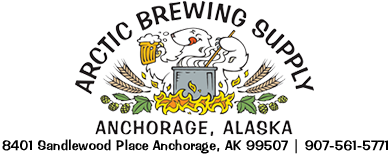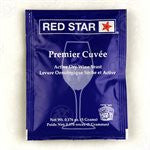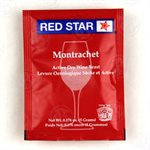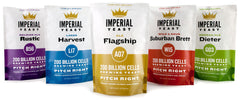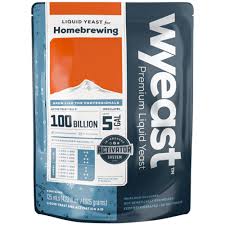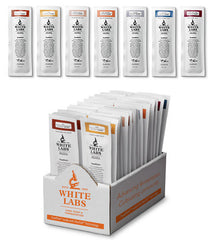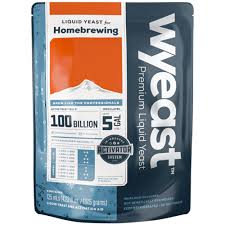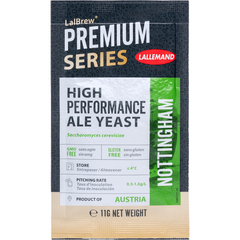Premier Cuvee-A fast, clean and neutral yeast recommended for reds, whites and especially champagnes.
Premier Rouge-A strong even fermenter, produces full bodied reds especially when used with grapes from the Cabernet family.
Montrachet-Ferments grape and fruit musts to dryness and is noted for its low volatile acidity and complex flavors.
Pasteur Champagne-Neutral flavor, recommended for white wines and fruit juices but despite it's name it is not recommended for sparkling wines or champagnes.
Bourgovin RC 212
Saccharomyces cerevisiae
Origin
The Bourgovin RC 212 strain was selected from fermentations produced in the Burgundy region by the Bureau interprofessionnel des vins de Bourgogne (BIVB). It was selected for its ability to ferment a traditional heavier-style Burgundian Pinot Noir.
Oenological properties and applications
The RC 212 is a low-foaming moderate-speed fermenter with an optimum fermentation temperature ranging from 20° to 30°C (68° to 86°F). A very low producer of hydrogen sulfide (H2S) and sulfur dioxide (SO2), the RC 212 shows good alcohol tolerance to 16%.
The RC 212 is recommended for red varieties where full extraction is desired. Lighter red varieties also benefit from the improved extraction while color stability is maintained throughout fermentation and aging. Aromas of ripe berry and fruit are emphasized while respecting pepper and spicy notes.
An excellent choice for both young & aged red wines.
ICV D-47
Saccharomyces cerevisiae
Origin
This strain was isolated from grapes grown in the Côtes-du-Rhône region of France by Dr. Dominique Delteil, head of the Microbiology Department, Institut coopératif du vin (ICV), in Montpellier. ICV D-47 strain was selected from 450 isolates collected between 1986 and 1990.
Oenological properties and applications
The ICV D-47 is a low-foaming quick fermenter that settles well, forming a compact lees at the end of fermentation. This strain tolerates fermentation temperatures ranging from 15° to 20°C (59° to 68°F) and enhances mouthfeel due to complex carbohydrates. Malolactic fermentation proceeds well in wine made with ICV D-47.
Recommended for making wines from white varieties such as Chardonnay and rosé wines. An excellent choice for producing mead, however be sure to supplement with yeast nutrients, especially usable nitrogen.
An excellent choice for dry whites, blush wines and residual sugar wines.
71B-1122
Saccharomyces cerevisiae
Origin
Selected in Narbonne at the Institut national de recherche en agriculture (INRA) by J. Maugenet. The selection was designed to isolate yeasts that would produce a fruity yet fresh character in wine that would live long after fermentation.
Oenological properties and applications
The 71B strain is a rapid starter with a constant and complete fermentation between 15° and 30°C (59° and 86°F) that has the ability to metabolize high amounts (20% to 40%) of malic acid. In addition to producing rounder, smoother, more aromatic wines that tend to mature quickly, it does not extract a great deal of phenols from the must so the maturation time is further decreased.
The 71B is used primarily by professional winemakers for young wines such as vin nouveau and has been found to be very suitable for blush and residual sugar whites. For grapes in regions naturally high in acid, the partial metabolism of malic acid helps soften the wine. The 71B also has the ability to produce significant esters and higher alcohols, making it an excellent choice for fermenting concentrates.
An excellent choice for blush & residual sugar whites, nouveau & young red wines. Also a good choice for late harvest wines.
ICV K1V-1116
Saccharomyces cerevisiae
Origin
Selected by the Institut coopératif du vin in Montpellier among numerous killer strains isolated and studied by Pierre Barre at INRA, the K1V-1116 strain was the first competitive factor yeast to go into commercial production and has become one of the most widely used active dried wine yeasts in the world.
Oenological properties and applications
The K1V-1116 strain is a rapid starter with a constant and complete fermentation between 10° and 35°C (50° and 95°F), capable of surviving a number of difficult conditions, such as low nutrient musts and high levels of sulfur dioxide (SO2) or sugar. Wines fermented with the K1V-1116 have very low volatile acidity, hydrogen sulfide (H2S) and foam production.
The K1V-1116 strain tends to express the freshness of white grape varieties such as Sauvignon Blanc, Chenin Blanc and Seyval. The natural fresh fruit aromas are retained longer than with other standard yeast strains. Fruit wines and wines made from concentrates poor in nutrient balance benefit from the capacity of K1V-1116 to adapt to difficult fermentation conditions. Restarts stuck fermentations.
Highly recommended for dry whites, aged reds, and late harvest wines.
EC-1118
Saccharomyces bayanus
Origin
The EC-1118 strain was isolated, studied and selected from Champagne fermentations. Due to its competitive factor and ability to ferment equally well over a wide temperature range, the EC-1118 is one of the most widely used yeasts in the world.
Oenological properties and applications
The fermentation characteristics of the EC-1118 — extremely low production of foam, volatile acid and hydrogen sulfide (H2S) — make this strain an excellent choice. This strain ferments well over a very wide temperature range, from 10° to 30°C (50° to 86°F) and demonstrates high osmotic and alcohol tolerance. Good flocculation with compact lees and a relatively neutral flavor and aroma contribution are also properties of the EC-1118.
The EC-1118 strain is recommended for all types of wines, including sparkling, and late harvest wines and cider. It may also be used to restart stuck fermentations.
An excellent choice for champagnes and late harvest wines. Also a very good choice for dry whites.
Ready to pitch, no refrigeration necessary.
Tags: Beer-brewing, Cider-making, Gluten-friendly, Mead-making, Soda, Winemaking
Type: Yeast Cultures
